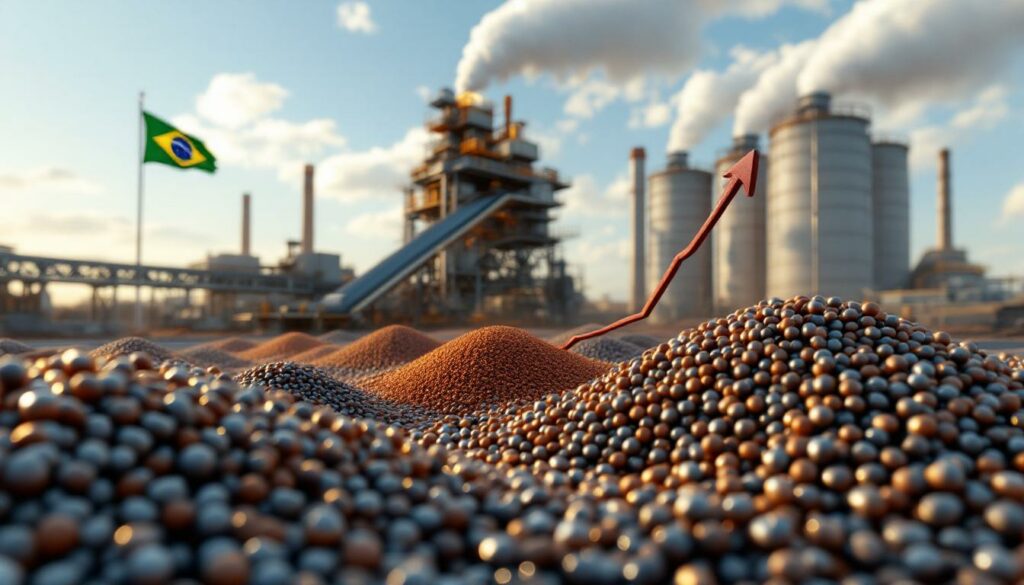What Are Iron Ore Agglomerates and Why Do They Matter?
Iron ore agglomerates represent a premium category of iron ore products that undergo processing to enhance their value and performance in steelmaking. These value-added products include pellets, sinter, and briquettes—each engineered to optimize blast furnace efficiency and reduce environmental impact.
Unlike raw iron ore fines, agglomerates provide consistent chemical composition and physical properties that translate into significant operational benefits for steel producers. Pellets, in particular, offer superior permeability in blast furnaces, allowing for more efficient gas flow and reduced coke consumption.
Types of Iron Ore Agglomerates
Pellets: Small, marble-sized balls (typically 8-16mm) created by combining iron ore concentrates with binding agents and firing them in an induration furnace. They offer:
- Higher iron content (64-67% Fe versus 58-62% for standard fines)
- Lower impurities (especially silica, phosphorus, and alumina)
- Superior metallurgical properties during reduction
Sinter: Created by partially melting iron ore fines with fluxes and coke breeze on a moving grate. While less premium than pellets, sinter offers:
- Improved permeability in blast furnaces
- Ability to incorporate recycled materials
- Lower production costs than pellets
Briquettes: Compressed forms of iron-bearing materials, usually cold-bonded with binders like lime or cement. These offer:
- Route for utilizing ultrafine iron ore waste
- Lower energy requirements in production
- Alternative for operations without pelletizing facilities
Strategic Importance in the Global Market
The premium status of agglomerates stems from their operational and environmental advantages. Steel mills willingly pay substantial premiums—typically $20-40 per ton over standard 62% Fe fines—for these benefits:
"Premium iron ore products like pellets command higher prices because they reduce operating costs elsewhere in the steelmaking process. The efficiency gains often outweigh the premium paid."
As global decarbonization efforts intensify, the demand profile for agglomerates continues to evolve. High-grade agglomerates enable:
- Reduced carbon emissions (up to 30% less CO₂ per ton of steel)
- Decreased energy consumption
- Enhanced productivity in steel mills
This strategic significance explains why production adjustments by major suppliers like Vale can impact both pricing and availability across the steel value chain.
What Changes Did Vale Announce to Its Production Targets?
Vale, one of the world's largest iron ore producers, has significantly revised its production forecast for iron ore agglomerates in 2025. The announcement, made on July 2, 2025, represents a substantial reduction in projected output for these premium products.
Original vs. Revised Production Forecasts
The scale of Vale's revision is substantial:
| Forecast Type | Previous Target (Mt) | Revised Target (Mt) | Reduction (Mt) | Reduction (%) |
|---|---|---|---|---|
| 2025 Agglomerates | 38-42 | 31-35 | 7 | ~18% |
This 7 million metric ton reduction represents approximately 18% of Vale's previously projected agglomerate production capacity for 2025. For context, this volume alone would constitute a mid-sized producer's entire annual output.
Timing and Context of the Announcement
Vale's announcement came amid growing concerns about iron ore demand insights, particularly in China, which consumes over 70% of seaborne iron ore. The timing of the announcement—mid-year—suggests the company is making proactive adjustments based on market signals rather than reactive changes to unforeseen circumstances.
The revision forms part of Vale's regular production guidance updates, but the magnitude of the change has drawn significant market attention. Industry analysts note that such substantial revisions typically signal broader market concerns rather than isolated operational issues.
Particularly noteworthy is that this announcement follows recent reports of declining iron ore prices, with benchmark 62% Fe fines experiencing downward pressure in the preceding quarter. The premium segment, including pellets, has not been immune to these market forces.
What Factors Are Driving Vale's Production Forecast Reduction?
Vale's decision to reduce its iron ore agglomerates production forecast stems from a combination of market conditions and operational considerations. Understanding these factors provides insight into both company strategy and broader market dynamics.
Current Market Conditions for Iron Ore Pellets
The primary driver cited by Vale is "current market conditions for pellets," which reflects several underlying trends:
- Softening demand signals: Particularly from European and Asian steelmakers, who are grappling with overcapacity issues and lower-than-expected steel consumption
- Compressed premium differentials: The price premium for pellets over standard 62% Fe fines has narrowed from historical levels
- Shifting blast furnace operations: Steel mills optimizing input costs by adjusting their raw material mix to reduce dependency on premium products
These market dynamics appear to be creating a temporary environment where the economic case for maximizing premium production has weakened.
Planned Maintenance at São Luis Pelletizing Plant
Vale has strategically decided to advance preventive maintenance at its São Luis pelletizing plant during the third quarter of 2025. This decision represents both operational necessity and market opportunism:
- Complete production suspension: The maintenance will halt production entirely during the maintenance period
- Strategic timing: Vale is leveraging the softer market conditions to conduct maintenance, minimizing revenue impact
- Asset optimization: The preventive nature suggests Vale is prioritizing long-term plant reliability over short-term production targets
The São Luis facility is a critical component of Vale's pellet production network, with significant capacity impact when offline.
Global Steel Industry Dynamics
While not explicitly detailed in Vale's announcement, the company's decision reflects broader steel industry trends:
- Chinese construction slowdown: Reduced infrastructure and property investment impacting steel demand
- Evolving environmental regulations: Changing emissions standards affecting input preferences
- Technology transitions: Growing interest in direct reduction ironmaking (DRI) and electric arc furnace (EAF) production, which utilize different raw material profiles
These industry shifts appear to be influencing Vale's production strategy as the company calibrates its output to match evolving market requirements.
How Does This Compare to Vale's Overall Iron Ore Strategy?
Vale's revision to its agglomerates production forecast represents a tactical adjustment within its broader iron ore strategy rather than a fundamental shift in direction. To understand the significance, we must examine how it fits within the company's overall market positioning and operational approach.
Vale's Position in the Global Iron Ore Market
As one of the "Big Four" iron ore producers alongside Rio Tinto, BHP, and Fortescue Metals Group, Vale's strategic decisions carry significant market weight:
- Production scale: Vale remains the world's largest iron ore pellet producer despite the forecast reduction
- Quality focus: The company's strategic emphasis on high-grade, low-impurity products continues to differentiate its portfolio
- Integrated logistics: Vale's "mine-to-market" capabilities through dedicated rail, port, and shipping assets support its premium product strategy
The agglomerates reduction represents a volume adjustment rather than a retreat from Vale's quality-focused positioning in the market.
Recent Production Performance
Vale's agglomerate production trajectory has shown notable volatility in recent years:
- Post-Brumadinho recovery: Following the 2019 tailings dam disaster, Vale's production volumes have been gradually rebuilding
- Operational resilience: Despite COVID-19 disruptions, Vale maintained relatively stable pellet operations compared to competitors
- Quality enhancement initiatives: Ongoing investments in beneficiation and processing to increase the share of premium products
The current forecast reduction appears to be a temporary adjustment rather than a continuation of production challenges faced in previous years.
Long-term Production Goals
Vale's long-term strategy continues to emphasize balancing volume with value:
- "Value Over Volume": The company has consistently messaged prioritizing margin over tonnage
- Flexibility principle: Production plans designed with adjustment mechanisms to respond to market conditions
- Premium product leadership: Continued investments in processing capabilities to maintain competitive advantage in high-grade segments
This adjustment demonstrates Vale's willingness to adapt tactically while maintaining its strategic direction in premium iron ore products.
What Is Happening in the Broader Iron Ore Market?
The iron ore market is experiencing significant shifts that provide context for Vale's production adjustment. Understanding these broader dynamics helps explain the rationale behind the company's decision.
Current Iron Ore Price Trends
Iron ore prices have shown increasing volatility in recent quarters:
- Benchmark price pressure: Standard 62% Fe fines have experienced downward movement from 2024 highs
- Premium compression: The premium for high-grade products has narrowed from $30-40/ton to $15-25/ton above benchmark
- Quality differentiation: Despite overall pressure, the quality spread between high and low-grade ores remains historically wide
This pricing environment suggests that while premium products retain their value advantage, the absolute premium may not justify maximum production during maintenance periods. Recent iron ore price trends indicate continued volatility in the market.
Chinese Demand Dynamics
China, consuming approximately 70% of seaborne iron ore, continues to drive market sentiment:
- Property sector weakness: Ongoing challenges in China's real estate market have dampened steel demand
- Infrastructure stimulus limitations: More targeted government spending providing less support than previous cycles
- Environmental policies: "Blue sky" initiatives periodically restricting steel production in key manufacturing hubs
These factors have created a more cautious outlook for iron ore demand, particularly affecting premium products that often serve higher-quality construction and manufacturing applications.
Global Supply-Demand Balance
The iron ore market is experiencing evolving supply dynamics:
- Major producer discipline: Rio Tinto, BHP, and Vale all showing restraint in expansion plans
- New entrants: Smaller producers in Australia and Brazil bringing modest volumes online
- Potential oversupply risk: Market projections suggesting potential surplus in standard grades while premium segments remain tighter
This nuanced supply picture suggests Vale is proactively managing its product mix to avoid contributing to potential oversupply in specific market segments.
How Might This Impact Vale's Financial Performance?
Vale's decision to reduce its agglomerates production forecast has several potential financial implications. While precise financial impacts depend on market conditions through 2025, we can identify key areas of influence.
Revenue Implications
Agglomerates, particularly pellets, represent a significant value driver for Vale:
- Premium product pricing: Pellets typically command $20-40/ton premium over 62% Fe fines
- Revenue mix contribution: Premium products historically contribute disproportionately to profit margins
- Offset potential: Redirecting some production to standard fines could partially mitigate volume reduction impacts
Based on current market conditions, the 7 million ton reduction could represent $350-700 million in potential revenue impact, depending on premium levels and the company's ability to redirect production.
Cost Management Considerations
The maintenance-driven production adjustment also has cost implications:
- Fixed cost absorption: Lower volumes increase per-ton fixed costs across remaining production
- Maintenance optimization: Concentrating maintenance during market weakness minimizes opportunity cost
- Operational efficiency: Potential for improved performance following maintenance completion
Vale's decision to advance maintenance during softer market conditions represents a pragmatic approach to managing both costs and revenue optimization.
Investor Perspectives
The market reaction to Vale's announcement reflects investor sentiment:
- Transparency value: Proactive guidance adjustment viewed positively for management credibility
- Disciplined approach: Support for prioritizing margin over volume during market weakness
- Recovery potential: Expectations that post-maintenance production could coincide with improved market conditions
"The decision to proactively manage premium production during softer markets demonstrates Vale's commitment to shareholder value over production targets."
Vale's strategic flexibility may provide long-term advantages despite short-term volume reductions.
What Are the Implications for the Global Steel Industry?
Vale's production adjustment sends signals beyond the iron ore market, potentially affecting steel producers worldwide. The implications vary by region and steelmaking technology.
Steel Producer Considerations
Steel manufacturers must evaluate several factors in response:
- Input availability: Potentially tighter supply of premium iron ore inputs during maintenance periods
- Blend optimization: Opportunities to adjust raw material mixes to optimize costs while maintaining quality
- Forward purchasing strategies: Potential for building strategic inventories ahead of maintenance periods
Larger, integrated steelmakers with flexible procurement options will likely navigate the adjustment with minimal disruption, while smaller producers with specific quality requirements may face greater challenges.
Environmental and Regulatory Factors
The reduction in premium products intersects with environmental considerations:
- Emissions impact: High-grade agglomerates typically enable lower-emission steelmaking
- Regulatory compliance: Steel producers in regions with strict emissions regulations may face additional challenges
- Decarbonization investments: Potential acceleration of alternative ironmaking technologies less dependent on traditional agglomerates
For steelmakers pursuing carbon reduction targets, the temporary reduction in premium iron ore availability may influence technology investment timelines.
Regional Market Differences
The impact varies significantly by geography:
- European producers: Generally more dependent on high-grade inputs due to environmental regulations
- Chinese steel sector: Greater flexibility to adjust input mix based on availability and cost
- Emerging market producers: Often more price-sensitive and adaptable to varying input qualities
This production adjustment highlights the interconnectedness of the iron ore and steel value chains, with upstream changes cascading through to steel production economics.
What's Next for Vale's Iron Ore Business?
Looking beyond the immediate production adjustment, Vale's iron ore business faces several strategic considerations that will shape its trajectory through 2025 and beyond.
Production Recovery Timeline
The announced maintenance provides a specific recovery framework:
- Q3 2025 maintenance period: Complete suspension of São Luis pelletizing operations
- Q4 2025 ramp-up: Expected return to full production capacity
- 2026 outlook: Potential for revised guidance based on market conditions and maintenance outcomes
This scheduled maintenance creates a clear timeline for production normalization, assuming no unexpected complications arise during the work.
Strategic Alternatives
Vale maintains several options to optimize its iron ore business during and after the maintenance period:
- Product mix flexibility: Ability to redirect some high-grade ore from pelletizing to direct shipping
- Asset utilization: Potential to adjust utilization rates at other pelletizing facilities to partially offset São Luis suspension
- Marketing strategy: Opportunity to prioritize highest-margin customer segments during periods of reduced availability
These alternatives demonstrate Vale's operational flexibility despite the headline production reduction. According to Vale's official update on low-carbon solutions, the company remains committed to sustainable production methods.
Long-term Outlook
Beyond 2025, Vale's iron ore strategy continues to evolve:
- Capacity optimization: Balancing maintenance requirements with market conditions
- Quality enhancement: Ongoing investments in beneficiation to increase premium product capabilities
- Value chain integration: Potential for strategic partnerships with steelmakers seeking secure premium supply
The company's long-term commitment to premium iron ore products remains intact, with the current adjustment representing a tactical response to market conditions rather than strategic redirection. The 2025 iron ore forecast suggests continued volatility in the market that Vale must navigate.
FAQ: Vale's Iron Ore Agglomerates Production
What exactly are iron ore agglomerates?
Iron ore agglomerates are processed forms of iron ore that have been transformed from raw fines into more valuable, engineered products. The most common types are pellets (small, marble-sized balls created through grinding, mixing with binders, and heating) and sinter (created by partially melting iron ore fines on a conveyor). These products provide enhanced performance in blast furnaces due to their consistent size, chemistry, and physical properties.
Why are pellets and other agglomerates considered premium products?
Agglomerates command premium prices for several reasons:
- Higher iron content: Typically 64-67% Fe versus 58-62% for standard fines
- Lower impurities: Reduced silica, alumina, and phosphorus content
- Better metallurgical performance: Improved permeability in blast furnaces, faster reduction kinetics
- Operational benefits: Lower coke consumption, higher productivity, reduced emissions
- Transportation efficiency: Less moisture and better handling characteristics
These advantages translate into operational cost savings that often justify the price premium for steelmakers.
How significant is this production forecast reduction for Vale?
The 7 million ton reduction represents approximately 18% of Vale's previously projected agglomerate production for 2025. While substantial, this volume represents less than 3% of Vale's total iron ore production capacity. The significance lies more in the value impact than volume, as agglomerates generate higher margins than standard products. The reduction's timing—coinciding with scheduled maintenance—suggests a strategic adjustment rather than a response to unforeseen challenges.
Could Vale revise its forecast again before the end of 2025?
Vale routinely evaluates its production guidance based on market conditions, operational performance, and strategic priorities. Additional revisions remain possible, particularly if:
- Market conditions change significantly (either improving or deteriorating)
- Maintenance scope at São Luis expands or contracts based on findings
- Other production assets experience unexpected operational developments
The company's demonstrated willingness to provide transparent guidance updates suggests they would communicate any material changes to the current forecast.
How does this compare to production adjustments by other major iron ore
Looking to Capitalise on ASX Mining Discoveries?
Gain immediate notifications on significant mineral discoveries through Discovery Alert's proprietary Discovery IQ model, turning complex data into actionable investment insights. Start your 30-day free trial today at Discovery Alert and position yourself ahead of the market.




